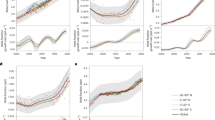Abstract
The Montreal Protocol on Substances that Deplete the Ozone Layer1 is an agreement to reduce production and emissions of chlorofluorocarbons (CFCs) motivated primarily by the need to protect the Earth's ozone layer. The possible effects of CFCs on global climate were noted as an additional cause for concern. Here, the effect of the protocol on future concentrations of CFC-11 (CFCl3) and CFC-12 (CF2Cl2) is examined, and the greenhouse-effect implications are evaluated. The protocol reduces the 1986–2030 warming commitment attributable to CFCs by a factor of three to seven, but high CFC concentrations (up to four times present levels for CFC-12) would still occur eventually unless further restrictions are imposed.
This is a preview of subscription content, access via your institution
Access options
Subscribe to this journal
Receive 51 print issues and online access
$199.00 per year
only $3.90 per issue
Buy this article
- Purchase on Springer Link
- Instant access to full article PDF
Prices may be subject to local taxes which are calculated during checkout
Similar content being viewed by others
References
United Nations Environment Programme, Montreal Protocol on Substances that Deplete the Ozone Layer (United Nations Environment Programme, Nairobi, 1987).
Rasmussen, R. A. & Khalil, M. A. K. Science 232, 1623–1624 (1986).
Wigley, T. M. L. Clim. Monit. 16, 14–28 (1987).
Brühl, C. & Crutzen, P. J. Climate Dyn. 2, 173–203 (1988).
Gammon, R. H. & Wofsy, S. C. in Atmospheric Ozone 1985: Assessment of Our Understanding of the Processes Controlling its Present Distribution and Change, Global Ozone Research and Monitoring Project, Report No. 16 (World Meteorological Organisation, Geneva, 1985).
Dickinson, R. E. & Cicerone, R. J. Nature 319, 109–115 (1986).
Hammitt, J. K. et al. Nature 330, 711–716 (1987).
Hough, A. M., Penkett, S. A., Eggleton, A. E. J., Schmidt, U. & Knapska, D. A Single Dimension Modelling Study of the Vertical Profiles of Halocarbons and Hydrocarbons at 44°N, AERE R 12588, (UK Atomic Energy Authority, Harwell, 1987).
Chemical Manufacturers Association Production, Sales, and Calculated Release of CFC-11 and CFC-12 through 1986 (Chemical Manufacturers Association, Washington, DC, 1987).
Borisenkov, E. P. & Kazakov, Y. E. Trudy Gl. Geofiz. Obs. 438, 62–74 (1980).
Gamlen, P. H., Lane, B. C. & Midgley, P. M. Atmos. Envir. 20, 1077–1085 (1986).
Ramanathan, V., Cicerone, R. J., Singh, H. B. & Kiehl, J. T. J. geophys. Res. 90, 5547–5566 (1985).
Trabalka, J. R., Edmonds, J. A., Reilly, J. M., Gardner, R. H. & Voorhes, L. D. in Atmospheric Carbon Dioxide and the Global Carbon Cycle (ed. Trabalka, J. R.) 247–287 (US Dept of Energy, Washington, DC, 1985).
Wigley, T. M. L. Geophys. Res. Lett. 14, 1135–1138 (1987).
Author information
Authors and Affiliations
Rights and permissions
About this article
Cite this article
Wigley, T. Future CFC concentrations under the Montreal Protocol and their greenhouse-effect implications. Nature 335, 333–335 (1988). https://doi.org/10.1038/335333a0
Received:
Accepted:
Issue Date:
DOI: https://doi.org/10.1038/335333a0
This article is cited by
-
Stratospheric ozone, UV radiation, and climate interactions
Photochemical & Photobiological Sciences (2023)
-
Analysis of the impact of flow characteristics on the separation efficiency and pressure drop of a cyclone-type oil separator
Journal of Mechanical Science and Technology (2022)
-
Environmental effects of stratospheric ozone depletion, UV radiation, and interactions with climate change: UNEP Environmental Effects Assessment Panel, Update 2020
Photochemical & Photobiological Sciences (2021)
-
The effect of changing climate on the frequency of absolute extreme events
Climatic Change (2009)
-
Effects of CFC substitutes
Nature (1990)
Comments
By submitting a comment you agree to abide by our Terms and Community Guidelines. If you find something abusive or that does not comply with our terms or guidelines please flag it as inappropriate.



